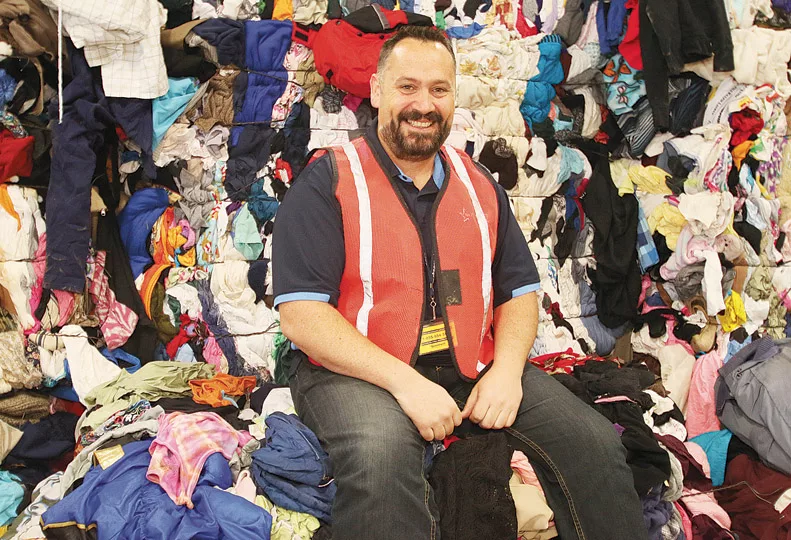Goodwill reducing waste through outlet center
Unsold materials salvaged at Front Street warehouse

Spokane-based Goodwill Industries of the Inland Northwest is reducing its waste stream through its outlet and salvage center that so far has cut its disposal bills by more than a third.
In 2015, the outlet center’s second full year of operation, Goodwill paid out $400,000 in disposal fees, down from $600,000 during the center’s first full year of operation, says Heather Alexander, spokeswoman for Goodwill here.
In 2015, Goodwill received 23 million pounds of donated items.
“We were able to get value out of 80 percent of donated items through retail store sales, online sales, recycling, and salvage,” she says. “We want to get as much value as we can out of donations people have entrusted to us.”
The goal is to cut down to the zero-waste standard, which Alexander says currently is defined as less than 10 percent of discarded material being buried or burned.
Jim Stailey, Goodwill’s vice president of operations, says the waste-reduction rate is continuing to improve as the outlet center becomes more efficient and as vendors identify more materials to recycle or salvage.
Stailey calculates that Goodwill realized $22,000 in disposal cost savings through recycling alone in February, the most recent month for which data is available. “That doesn’t count revenue from outlet sales,” he says.
Goodwill operates 23 retail stores and 12 donation collection sites in Eastern Washington and northern Idaho.
The outlet center, which has 48 employees, is located in the former Cascade Seed warehouse, at 1406 E. Front, east of downtown. Goodwill bought the 101,000-square-foot building in late 2012 and opened the outlet center a year later.
The retail portion of the center occupies 10,000 square feet, and the salvage operations occupy 54,000 square feet of warehouse space. Sky High Sports Spokane LLC leases most of the rest of the building.
It’s the first outlet center for Goodwill here, but the concept isn’t new to Rockville, Md.-based Goodwill Industries International, Alexander says.
Goodwill stores typically send items to the outlet center that haven’t sold after being on retail shelves for five weeks.
“We have to keep it fresh and make room for new donations,” Alexander says.
Stores pack unsold and damaged items in 4-foot, cube-shaped cardboard containers called Gaylord boxes, and Goodwill transports them to the outlet center warehouse where they’re tipped into large bathtub-sized bins called boats, which are placed on wheeled tables and rolled into the outlet store, where customers await their arrival.
At least 24 boats are rotated through the store at any time, and furniture and other large items are displayed around the edges of the sales floor.
Alexander says regular customers range from merchandise resellers to fashion designers who are looking for items to sell through their respective businesses.
“Some people spend hours here,” she says, adding that the outlet is open seven days a week.
“You can still get some good finds here,” Alexander says. “It helps us get additional value from things that haven’t sold in the stores.”
Most items in the boats are sold by the pound with prices set at $1.59 per pound for purchases of up to 10 pounds, $1.39 per pound for 10 to 25 pounds, and 89 cents per pound for more than 25 pounds. Glassware is 39 cents a pound.
Larger, heavier items, including furniture, appliances, and bikes, are sold on a per-item basis.
Sales are final, unlike in Goodwill stores, where most items can be returned for store credit within two weeks of purchase, Alexander says.
Every few hours, a few picked-over boats are returned to the warehouse and replaced in the rotation with boatloads of newly arrived items.
Items remaining in boats returning to the warehouse then go through the recycle and salvage process.
The warehouse is equipped with bailers and crushers to process textiles, plastics, and cardboard.
Once processed in bulk volumes, the materials are sold to vendors as commodities.
Some items, such as baseball caps, plush toys, metal objects, and shoes, are separated into their own Gaylord boxes.
Goodwill fills two to three Gaylords daily just with baseball caps, Stailey says.
“We have a couple of buyers,” he says, although he adds that he’s not sure what the buyers do with all those hats.
Stailey says textiles are the biggest source of salvage revenue.
Half-ton textile bales are sold to a number of vendors, some for local use and others for overseas users.
Shoes have some of the highest salvage value per pound, although they don’t make up as much volume as textiles, he says.
Some vendors resell shoes overseas, and others recycle and repurpose materials they’re made of, he says.
In a separate recycling effort, Goodwill contracts with the state of Washington to collect electronic devices, such as desktop computers, monitors, laptops, tablets, televisions, portable DVD players, and e-readers.
Most items collected through the E-Cycle program are disassembled into recyclable commodities at “demanufacturing” facilities in Western Washington, Stailey says.
Goodwill collected more than 2 million pounds of E-Cycle items last year, he says.
Households, small businesses, schools, small governments, and charities can drop of such items at any Goodwill store or donation station, Stailey says.
The E-Cycle program was set up in 2009 thanks to state law that requires manufacturers of certain electronics sold in Washington to pay for the recycling of those products.
The Washington state Department of Ecology regulates the program, although it’s run by a Woodland Wash.-based industry group named the Washington Materials Management and Financing Authority.
Goodwill’s E-Cycle operation is based at a warehouse in Spokane Valley, but will be moved in December to the outlet center warehouse, Stailey says.
Alexander says the end goal of Goodwill’s revenue-generating operations is to support the nonprofit’s community services, which include helping veterans, the disabled, and disadvantaged people get jobs and housing.
She says 85 percent of Goodwill’s proceeds support its mission services.
“The only reason we do this is for services for the community,” Alexander says.
In 2014, Goodwill Industries of the Inland Northwest’s sales revenue from donated goods totaled $20.9 million, according to the agency’s most recently published annual report.
Goodwill served more than 6,300 people in 23 counties in Eastern Washington and North Idaho, providing nearly 57,000 hours of paid, on-the-job training and assessments that year, the report says.
Related Articles


_c.webp?t=1763626051)

_web.webp?t=1764835652)
